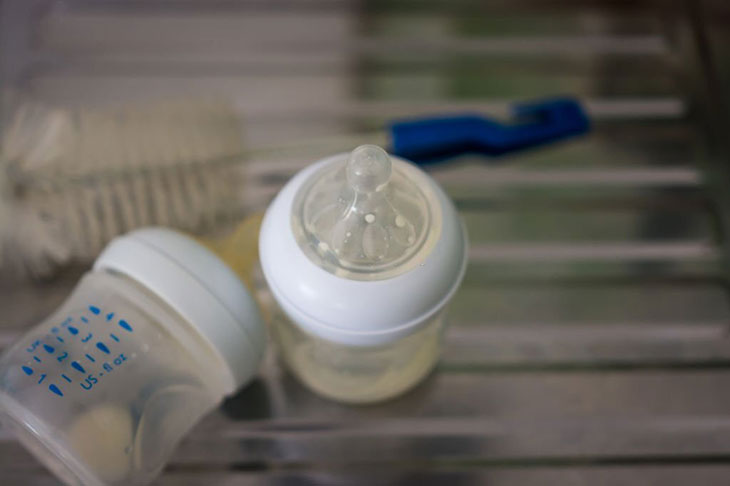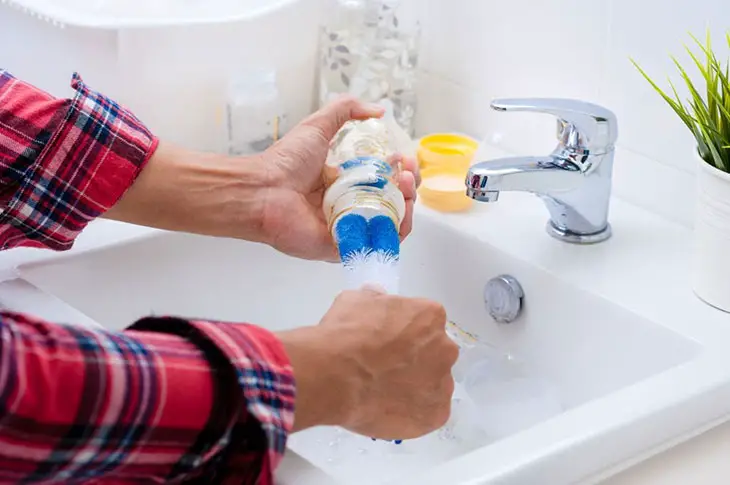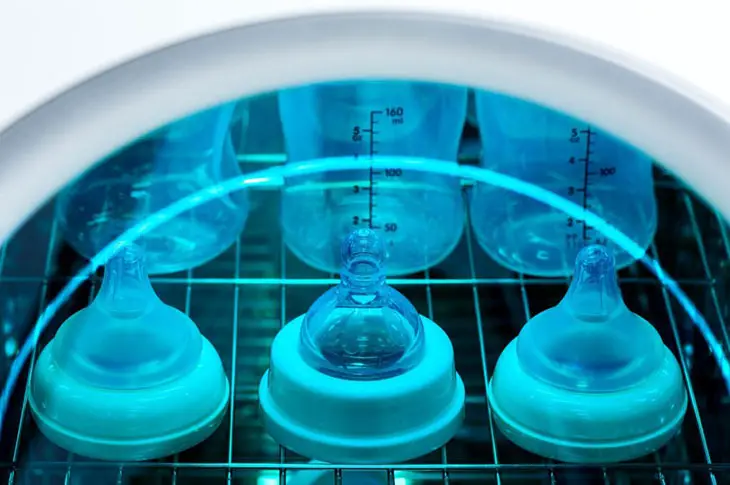With regular bottle-fed babies, how to keep the bottle clean and get the risk of formula residue in bottle is always a top concern for many mothers.
Because in the first six months, the baby’s immune system is not fully developed, carelessly sterilizing baby bottles can increase the risk of contracting harmful pathogens.
As a result, babies are more susceptible to infections and gastrointestinal diseases.
So, what is the best way to clean formula residue? Let’s find out too!
Formula Residue In Bottle – How To Get Risk Of It?

Let’s find out some helpful ways to solve this problem
Soak In A Large Basin Or Bowl With Vinegar

White vinegar is going to be your new best buddy. If you’ve never used vinegar as a cleaning solution in your household, this one will persuade you.
Vinegar offers excellent sanitizing properties to erase films, white patches, and milk residues and is ideal for bottles and pump elements.
It would be better if you only used the vinegar bath once a week or when you notice some stains forming.
How to clean baby bottles with vinegar?
- Prepare two bowls or jars, then pour 2-3 cups of vinegar into each.
- Disintegrate all vessels and pump pieces, clean with warm water, then soak it for 5 minutes in vinegar liquid.
- Remember to rinse with clean water before proceeding on to the next step.
- Check out some tips to clean with vinegar.
Let It Stand In Hot Soapy Water

Mix some warm liquid soap in the other mixing basin to wash the bottle and pump items after the vinegar treatment.
To guarantee that every component is thoroughly cleaned, use a bottle brush and any other soft brush that can comfortably accommodate the crevices, cracks, and tubes of your bottle.
Instead of prodding or extending the hole with the scratchy bristles of a soft bristle brush, the small finger fits perfectly into the tip of the nipple of a bottle.
Rinse thoroughly with water before placing it in the sterilizer.
Disinfect For Cleaning

Bacteria can be found in faucets, bottle cleaners, other objects, and leftover milk and saliva. And cleaning can be a vital step in preventing infections and yeast.
Bottle sterilizers, available in a variety of shapes and sizes, can come in handy.
Some are prepared in microwaves, while others are prepared electrically. You can choose either way, as long as it is simple and effective.
Before reusing it, you should treat it with a quick rinse.
Heat Or Air Dry

If you intend to rinse the nipple and container part by hand, use a disposable towel (such as paper towels) and avoid using a reusable fabric such as kitchen utensils, t-shirts, or other disposable textiles to clean the bottle’s parts.
Caution that bacteria flourish in wet material; if you are not careful, it will adhere to your newly washed and disinfected feeding equipment.
Wash your hands and dry them thoroughly, so the bottle remains clean when you touch it after cleaning.
After drying, preserve your hand feeders in a sealed bag or zippered compartment until appropriate to use.
Allowing your feeding apparatus to sit outside exposes it to filth, dust, and microbiological pollutants that you may easily prevent if properly kept.
Why Is It Important To Keep The Bottle Clean?
Bottles are the most important and necessary source of milk for your babies when they can hold their own bottles.
Therefore, this feeding equipment needs to be kept hygienic as certain microorganisms, such as viruses, bacteria, and fungi, can accumulate in the bottle.
They then invade the baby’s milk and enter the body, causing vomiting, thrush, or diarrhea. Therefore, you have to sterilize the bottle of formula properly before using it.
Sanitizing bottles is not necessarily to be done immediately after each bottle feeding, as long as you rinse them with warm water and keep them in a clean container.
But occasionally, you should sterilize baby bottles (deep cleaning).
If your baby has a fever or flu, you must disinfect them more often and until it is completely weaned.
Tips To Better Clean The Baby Bottle
Down below are the best way to clean baby bottles and tips you may need.
Cleaning
- Take apart: Remove the entire bottle’s components (e.g., teat, bottle, cap, and valve).
- Wash: Leave bottle components and other things to wash under running water. The tap water might be either hot or chilly.
- Rinse: Fill the dishwasher with bottle components and other feeding items. (Make sure to keep small objects in an airtight container or mesh laundry bag so that they do not end up in the cleaner’s filter).
- Use hot water: If feasible, use hot water and a drying medium cycle (or clean installation) in the dishwasher to help kill more bacteria.
- Keep your hands clean: Wash your hands with warm water and soap before removing and keeping sanitized goods.
It should be noted that bottles are better be cleansed after each feeding. If your infant does not complete a formula bottle within 2 hours, discard it.
Bacteria can increase quickly when infant formula is put in partially used containers or used bottles are just washed (with a quick rinse) rather than cleansed.
Sanitizing
Refer to one of these methods to clean up all things (including bottle brushes and sinks). Please inquire with the item’s supplier about the best way to utilize it.
Boil
- Soak all parts with water in a pot.
- Heat the pot until the water is boiling over high heat.
- Leave it 5 minutes on high heat
- Use clean tongs to fish out the pieces.
Steam
- Place dismantled objects in a microwave or plug the steam device and sterilize, cool, and dry according to the manufacturer’s directions.
Bleach
Use bleach if you can’t boil, steam, or use the dishwasher.
- Make a cleaning solution with a ratio of 2 tablespoons of unscented bleach per gallon (16 cups) of water in a clean wash basin.
- Put everything fully underwater (and water will enter the bottle). Check that the liquid covers all the pieces and that there are no air pockets in the bottle.
- Push the solution through the pores in the nipple.
- Soak the objects for at least 2 minutes in the solution.
- Remove your clean hands or tongs. Rinsing will allow germs to re-enter the cleansed things.
- Any remaining bleach will start to deteriorate when it dries and will not harm your baby. The procedure is similar to how dishes are disinfected at a restaurant.
Storage
To avoid bacteria and mold growth, allow feeding items, bottle brushes, and wash basins to air dry fully before storage.
When the goods are totally dry, stack them together and store them in a clean, well-protected location to avoid infection.
- Handwashing: Wash your hands thoroughly with soap and water.
- Put everything together: Put the clean and dry bottle components together.
- Safely store: Reconstituted baby plastic bottles and other feeding supplies, washbasins, and dry bottle brushes should be placed in a clean, safe place, such as a locked kitchen cabinet.
The Bottom Line
Cleaning baby bottles is an ongoing and time-consuming activity that consumes a significant portion of your day.
But we hope that with our articles, you know how to properly clean the formula residue in bottle quickly and conveniently!
